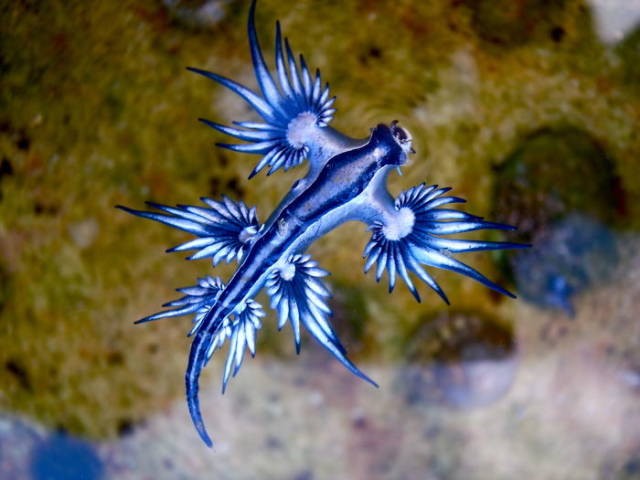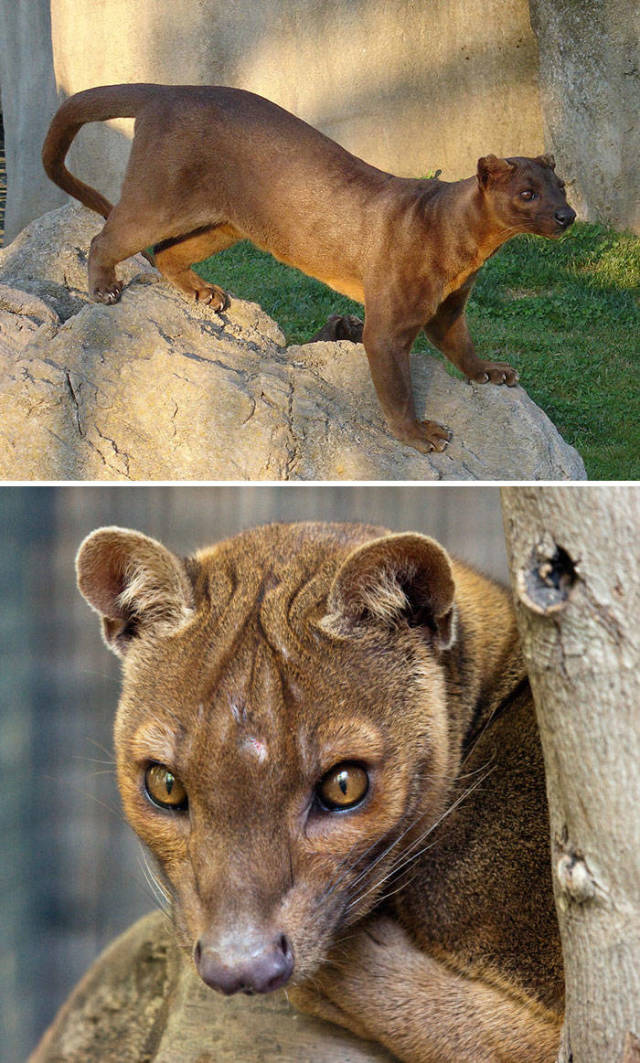These Are Not The Animals We Learned About In School (40 pics)
Venezuelan Poodle Moth
Discovered in Venezuela in 2009, this new species of alien-looking moth has poodle-like fur covering its head, thorax, abdomen, and even its wings.
1
Glaucus Atlanticus
Also known as the blue dragon, this creature is a is a species of blue sea slug. You could find it in warm waters of the oceans, as it floats on the surface because of a gas-filled sac in its stomach.
2
Dumbo Octopus
Dumbo octopus is an umbrella octopus found all around the world. Its name comes from Disney's "Dumbo" because of the creature's ears bearing similarity to the movies' title character.
3
Red-Lipped Batfish
Found on the Galapagos Islands, this fish is actually a pretty bad swimmer, and uses its pectoral fins to walk on the bottom of the ocean.
4
Lowland Streaked Tenrec
Found in Madagascar, Africa, this small tenrec is the only mammal known to use stridulation for generating sound – something that’s usually associated with snakes and insects.
5
Macropinna Microstoma
Macropinna microstoma is a species of fish that lives at a depth of about 600 metres (2,000 ft) to 800 metres (2,600 ft), hanging nearly motionless in the water. It is quite unusual with a transparent, fluid-filled dome on its head, through which the lenses of its eyes can be seen.
6
Tufted Deer
Found in central China, the tufted deer is a small species of deer characterized by a prominent tuft of black hair on its forehead and fang-like canines for the males. It is a timid, mainly solitary creature, that sometimes lives in pairs and enjoys living in areas with good cover.
7
Blue Parrotfish
This bright blue fish can be found in shallow water in the tropical and subtropical parts of the western Atlantic Ocean and the Caribbean Sea. They spend 80 percent of their time searching for food and eat small organisms found in the sand and algae that they scrape off rocks.
8
Panda Ant
Despite looking like an ant and being referred as such, it is in fact a form of wingless wasp. This insect is also known as cow-killer. Females possess thicker fur but lack wings. The furry panda ant lives for about 2 years.
9
Atretochoana Eiselti Or 'Penis Snake'
Atretochoana eiselti is a species of caecilian with a broad, flat head and a fleshy dorsal fin on the body. Although it is not a snake, it's been called a 'penis snake' in the media.
10
Sunda Colugo
Sunda Colugo or Sunda flying lemur is a species of colugo, native to Indonesia, Thailand, Malaysia, and Singapore. It is not, in fact, a lemur and it does not fly, gliding instead. Sunda Colugo is active at night and feeds on soft plant parts like young leaves, shoots, flowers, and fruits.
11
Japanese Spider Crab
The Japanese spider crab lives in the waters near Japan and has the largest leg span of any arthropod, reaching up to 5.5 metres (18 ft). Despite looking ferocious, the crab has been reported to have a gentle disposition.
12
Honduran White Bat
The Honduran white bat has distinctive white fur, with tips of individual hairs being gray as well as a leaf-shaped nose. They live in leaf 'tents' that they 'build' by cutting the side veins extending out from the midrib of large leaves.
13
Star-Nosed Mole
A a small mole found in wet low areas in the northern parts of North America, Star-nosed mole is easily identifiable by its snout which is used as a touch organ with more than 25,000-minute sensory receptors. Named Eimer's organs, the receptors are great at deteting seismic waves. 14
Saiga Antelope
This saiga, spread around the Eurasian steppe, is known for its an extremely unusual, over-sized, flexible nose structure, the proboscis. It is a critically endangered antelope.
15
Irrawaddy Dolphin
Irrawaddy Dolphin is an oceanic dolphin found in the Bay of Bengal and Southeast Asia. Its most notable feature is a round head with no distinct beak.
16
Sea Pig
Scotoplanes are sea cucumbers that live on deep ocean bottoms, specifically on the abyssal plain in the Atlantic, Pacific and Indian Ocean, typically at depths of over 1000 meters. They are deposit feeders, and obtain food by extracting organic particles from deep-sea mud.
17
Glass Frog
Found in South America, the glass frog is a family of amphibians with some specimens exhibiting an outstanding feature — transparent abdomens. Because the internal viscera is visible through the skin, the common name they are given is glass frogs.
18
Fossa
Fossa is a cat-like mammal that lives in Madagascar. Its classification has been controversial because physically it resembles a cat, while other traits suggest relation to viverrids. Genetic research has shown that they are actually their own separate species.
19
Spiny Bush Viper
Atheris hispida is a venomous viper from Central Africa. For their extremely keeled dorsal scales they are often called "rough-scaled bush viper" and "spiny bush viper".
20
Pacu
Pacu have square, straight teeth, which are uncannily similar to human teeth. Pacu, unlike piranha, mainly feed on plant material and not flesh or scales.
21
Blobfish
The blobfish is a deep sea fish that inhabits the deep waters off the coasts of mainland Australia and Tasmania, Zealand. The body of the blobfish is primarily a gelatinous mass with a density slightly less than water and this allows it to float above the sea floor without expending energy on swimming. They only appear droopy when taken out of the sea, when pressure changes drastically.
22
Goblin Shark
This rare shark is sometimes even called a “living fossil”, “is the only extant representative of the family Mitsukurinidae, a lineage some 125 million years old.” Goblin sharks inhabit the depths greater than 100 m (330 ft), with adults found deeper than juveniles. Given the depths at which it lives, the goblin shark poses no danger to humans.
23
Narwhal
This medium-toothed whale has a large "tusk" from a protruding canine tooth and is found in the arctic, has been valued for over 1000 years by the Inuit people for its meat and ivory. Narwhals, however, are especially vulnerable to climate change.
24
Superb Bird-Of-Paradise
Superb bird-of-paradise is a small bird that has a small female population, therefore the competition amongst males is fierce. Because of that, they have one of the most bizarre and elaborate courtship displays in the avian world.The male is black with an iridescent green crown, blue-green breast cover and a long velvety black erectile cape covering his back, while the female is a reddish-brown bird with brownish barred buff below.
25
Mata Mata
Found in South America, the mata mata is a freshwater turtle known for a large, triangular, flattened head characterized with many tubercles and flaps of skin, and a "horn" on its long and tubular snout.
26
Gobi Jerboa
Found in China and Mongolia, The Gobi jerboa is a species of rodent that lives in desert and steppe habitats. They have a long tail that helps them to accelerate their bipedal gallop. The most distinct feature is Gobi jerboa's ears that are almost as three times as large as their heads and give them a very keen hearing sense.
27
Pink Fairy Armadillo
Found in central Argentina, the pink fairy armadillo is the smallest species of armadillo. They have small eyes, silky yellowish white fur, and a flexible dorsal shell that is solely attached to its body by a thin dorsal membrane.
28
Leafy Seadragon
Found along the southern and western coasts of Australia, the leafy seadragon is a marine fish with long leaf-like protrusions coming from all over the body, that serves as camouflage.
29
Sea Pen
Sea pen is a colonial animal with multiple polyps that 'root' itself in sandy or muddy substrate. They mainly catch plankton. When touched, some sea pens emit a bright greenish light.
30
Axolotl
Also known as a Mexican salamander, the axolotl is a critically endangered salamander. They are used extensively for research because of their regenerative qualities.
31
Okapi
This mammal is native to the Democratic Republic of the Congo in Central Africa. Despite the zebra-like stripes, it is actually more closely related to giraffes. Okapi's coat is a chocolate to reddish brown, much in contrast with the white horizontal stripes and rings on the legs and white ankles.
32
Long-Wattled Umbrellabird
Native to Colombia, the long-wattled umbrellabird is a frugivorous bird. The male is distinguished by a large throat wattle of feathers, while females and juveniles have no or a much smaller wattle.
33
Lilac-Breasted Roller
Widely distributed in sub-Saharan Africa and the southern Arabian Peninsula, the lilac-breasted roller is a colorful bird that likes perching in hight trees and other vantage points where it can spot prey at ground level. Their bright plumage is unmistakable with deep lilac breast feathers.
34
Halitrephes Jelly
Halitrephes is a type of deep sea hydrozoan that lives at a depth of 4,000-5,000 feet.
35
Golden Tortoise Beetle
Native to the Americas, the golden tortoise beetle is a species of beetle that varies in color from reddish-brown with black spots through gold, and often metallic, earning it the nickname "goldbug". It tends to switch color in different conditions, such as during mating, and during times of disturbance, such as when it is touched by a researcher.
36
Aye-Aye
Native to Madagascar, aye-aye is the world's largest nocturnal primate. The most defining characteristic is aye-aye's way of feeding; the aye-aye taps on trees to find grubs, then gnaws holes in the wood using its forward slanting incisors to create a small hole in which it inserts its narrow middle finger to pull the tasty treat out.
37
Maned Wolf
Maned Wolf is the largest canid found in South America. It bears a striking resemblance to foxes, but is neither a fox now a wolf. The maned wolf participates in symbiotic relationships with other species and is shy around humans.
38
Satanic Leaf-Tailed Gecko
Satanic leaf-tailed gecko is a species of gecko that is found on the island of Madagascar. Their tail is flattened and appears to look like a leaf, helping the animal blend in within the environment.
39
Buff-Tip Moth
Found in Europe and Mongolia, the buff-tip is a quite large moth that resembles a broken twig when resting. Buff-tip's hindwings are creamy-white.
40
Credits: www.boredpanda.com
| facebook0 twitter0 pinterest 0 |
Tags: animals, unusual, wtf
from HD Wallpapers 4 u https://ift.tt/2IpIVuc
https://ift.tt/2jYNy45 https://ift.tt/2jqlqpT

